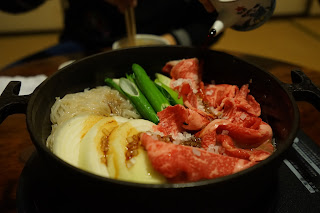This is
"Ume" plum blossoms that bloom first during the year. Although the
flowers were topped with snow in this cold and snowy day, "Ume" tells
us the spring is on the way.
My friend's
cheek turned red like the color of plum blossoms because she was not accustomed
with the cold weather. So we headed to warmer place.
Just before we
enjoyed "Ume" blossom, we had been sweet making class that is held in
traditional confectionery store located in Higashiyama district. One of the
confection that we made was formed into shape of "Ume".
She is making “Kinton” by using chopstick very
well. Green colored mushed paste represents the leave of pine tree. Pine is the
part of “Kadomatsu” traditional Japanese decoration of the New Year placed in
front of homes. Actually we could see it at the entrance of the confectionery
store.
In the Shintoism shrine, you can find wooden tablet called "Ema" and each shrine has its own shape. Here you can see tablet shaped with his symbol "hyotan" kind of gourd. The other tablet is the shape of "Zori" straw sandal that is related with Hideyoshi's life story.
We also stopped
by Toyokuni Shrine located nearby the store. Whole shrine was covered with
snow. When I visited here last spring, magnificent cherry blossom was bloomed
besides the torii gate that you can
view in my FB page. Still now they are waiting for upcoming spring.
This
shrine is associated with the historical figure of late 16C, Hideyoshi Tyotomi.
I have already written about him in the other article.
September
19, 2016 Relics of the tycoon Hideyoshi
Here you can see magnificent gate that is the relic of Hideyoshi’s castle. Nearby the shrine, there is also the relic of Toyotomi family, the historical bell of Hokoji temple.
In the Shintoism shrine, you can find wooden tablet called "Ema" and each shrine has its own shape. Here you can see tablet shaped with his symbol "hyotan" kind of gourd. The other tablet is the shape of "Zori" straw sandal that is related with Hideyoshi's life story.
It
was a cold and snowy night, Hideyoshi warmed up straw sandals of his master
Nobunag by putting them inside his cloth. Nobunaga appreciated his effort and
Hideyoshi successfully showed his loyalty and warmth to his master.
Unfortunately I didn’t have warmth to put my friend’s shoes inside cloth as
well as Hideyoshi. What I could do for her was to find some warmer and
comfortable places.
We
also enjoyed Maiko's Dance Performance held at Miyako Messe. It was nice place
to avoid the coldness and attract with traditional Japanese culture. Maiko, apprentice
of Geiko was wearing ornament and Kimono designed with “Ume” blossoms. Wearing
seasonal costume is one of their work. This cold and snowy day, we had enjoyed “Ume”
many times in different places.










